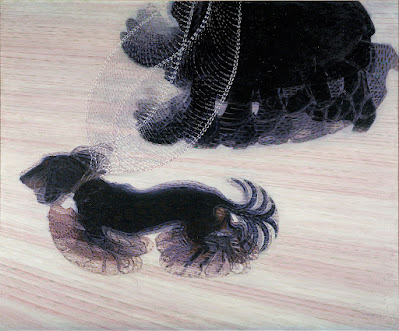37. (Italian) Futurism (1910-1920)
“This was a movement of intellectuals who wanted to replace tradition with the modern world of machinery, speed, violence, and public relations. It proves that we should be careful what intellectuals wish for, because we might get it.” – Brad Holland
What was it about? What were the goals?
This movement was an effort to radically change society for “the better” by embracing science and modernity, and through seeing the world in new ways. It was a movement that saw art as one of many tools to use in a greater effort. Unfortunately, it was hopelessly flawed by its misunderstanding of science, nature, and society – particularly in the acceptance of pseudo science like superior races, and a naïve view of a future world transformed by man without any negative consequences. This is an example of people with great intentions, advocating terrible ideas, who simply didn’t know any better.
Despite their flaws, Futurists did contribute some innovative artworks. They developed the notion of dynamism – of the interaction between people, places, and things. They also incorporated the idea of “simultaneity” in time––that the past, present, and future are connected. Balla said, “. . . moving objects constantly multiply themselves; their form changes like rapid vibrations, in their mad career. Thus a running horse has not four legs, but twenty, and their movements are triangular.”
As these artists travelled to Paris, they became heavily influenced by Cubism, borrowing heavily. The best way to see the difference between these two movements is in their subjects. While Cubists enjoyed painting portraits, still lifes, and nature, Futurists preferred to paint cities and modern vehicles in motion.
A bit of historical context:
So, this was an avant-garde movement that began in Milan, Italy in 1909, with a poet named Marinetti, who wrote up a Futurist Manifesto. The paper actually said little about painting (many more manifestos followed, on every art form), and spoke optimistically about the future, embracing new technology, science, progress, and change. The past, he believed, was holding society back and so traditions and taste should be eradicated. Meanwhile, the future would bring man’s triumph over nature (This was before we learned of global warming).
Marinetti was also very political, promoting nationalism, fascism, and freedom from Austria. His manifesto proclaimed, “We will glorify war —the world's only hygiene —militarism, patriotism, the destructive gesture of freedom-bringers, beautiful ideas worth dying for, and scorn for woman.” Marinetti worked closely with Mussolini and tried to promote modern art as being Italian, nationalist, anti-foreign, and anti-Semitic. It didn’t work. Mussolini and Hitler saw modern art as degenerate. Nevertheless, Marinetti’s ideas attracted a group of young artists who became the Futurists. Many of these artists, including Marinetti fought in WWI & II, and some died.
Fortunately the main thrust of this movement soon ended during WWI. Boccioni was killed in action, and the remaining artists separated into factions (Milan vs. Florence) and went separate ways. Marinetti tried to revive “il secondo Futurismo” in the 1960’s, but, by then, his influence was gone.
The underlying philosophy of the period:
The biggest problem with the Futurists was in creating a false choice between tradition and modernity. They thought society needed to erase everything and start over, and they even advocated violence to achieve this––the ends justified the means. This is also why they supported Mussolini and disliked democracy. They thought you needed a strong hand to force change quickly. In hindsight, it seems easy to say that modern isn’t always better. And we know now that the ends don’t always justify the means. But, they were just entering the modern world. They were naive, idealistic, foolhardy, and in some ways pig-headed.
How was it represented in the other arts – music, architecture, and literature?
Marinetti planned for Futurism to influence all areas of life: music, writing, architecture, design, and even food! Marinetti hated pasta, and wanted people to begin eating rice, grown in Italy. He even looked forward to a future of pills to replace food. However crazy this sounds, several followers did try to carry his ideas into different arts.
Antonio Sant’Elia was a Futurist architect who designed “La Città Nuova” in 1912-14. He was killed in action before any of his ideas could be built, but his writings were influential, leading to several structures that still exist today, like the train stations in Florence and Trento. Rovegno has a ghost town built in a Futurist style that no one wants to live in.
The two main composers of Futurist music were Pratella and Russolo, two people who scorned all the Italian composers of the past, and yet were never able to surpass them. I mean, have you ever heard of Pratella or Russolo? Enough said…
Was it great?
...No? Futurism is one of those examples where it’s hard to separate the art from the (awful) politics of its adherents. It’s a little like if Dr. Evil decided to paint his version of utopia. There are some works where I can admire the skill of conception and the impressive crafting of the image, but I’ve never seen a Futurist art work that really spoke to me or amazed me. And, the fact their star artist, Boccioni died young, certainly hurt the movement. Futurism answers the question, what happens when a new art form comes to a country where the people are generally dissatisfied and feel inferior, and so they think they’ve finally found a way to change things through art and they become delusional.
Some leading figures:
Giacomo Balla (1871-1958)
Filippo Marinetti (1876-1944) (poet)
Carlo Carrà (1881-1966)
Umberto Boccioni (1882-1916)
Gino Severini (1883-1966)
Luigi Russolo (1885-1947) (composer)
Antonio Sant’Elia (1888-1916) (architect)
Anton Bragaglia (1890-1960) (photographer)
Russian Futurists:
Kazimir Malevich (1879-1935)
Natalia Sergeevna Goncharova (1881-1962)
Aleksei Kruchonykh (1886-1968) (poet & playwright)
Some of the most famous artworks of the time:








Comments
Post a Comment